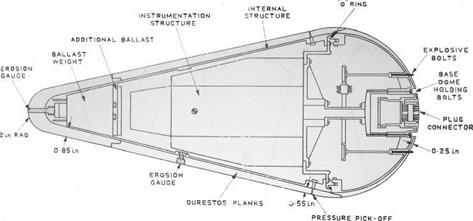BK09
Two stage. Launched 21 June 1960 at 19:35. Apogee 301 miles.
BK09, the second two-stage vehicle, was very successful. Separation of the second stage, initiation of the second stage boost and separation of the head from the second stage boost was satisfactory. The second stage boost ignited at the correct height on the downward trajectory prior to re-entry, and a re-entry velocity of 15,000 ft/second was achieved at 200,000 ft. The tape recorder in the head recorded data during re-entry down to 80,000 ft. Just prior to this an abnormal and completely unexpected increase in head oscillation occurred. The head broke up shortly after this and unfortunately the last inch or so of tape which had passed through the tape head was lost. This corresponded to the period immediately prior to head break-up. The break-up of the head at a low height during re-entry indicated that either the plank construction of the head was unsatisfactory or abnormally high loading was applied during re-entry, maybe resulting from an unstable oscillation.
The attempt to observe the re-entry with the Gaslight system showed that the instruments were not sensitive enough, that a better acquisition system was necessary, and that increased Black Knight performance was needed to raise the level of observables.
|
Figure 93. The BK09 re-entry head. |
BK07
Single stage. Launched 25 July 1960 at 21:24. Apogee 330 miles.
BK07 was a single-stage vehicle with a high drag heat shield head equipped to give data on heat transfer and re-entry dynamics. Extensive instrumentation was put in the motor bay to investigate base heating and pressure distribution. In addition, lightly loaded spring flaps were fitted to the pressure bleed holes in the propulsion bay to check the direction of flow through these holes. Their movement was monitored by telemetry.
Propulsion was satisfactory except that towards the end of the burning phase one of the four motors reverted to ‘cold’ thrusting and this resulted in a reduced re-entry velocity. This motor fault was subsequently attributed to a failure of a kerosene feed pipe.
The head separated from the main body but the additional thrust units in the head, provided to give increased separation, did not operate, nor did the turn over and spin thrust units. However, the head did re-enter nose first, but at a large initial incidence. The recovered head shows that impact was on the nose and that there was no re-entry burning on the afterbody. Head telemetry was extremely good and re-entry data was obtained. Complete dynamic analysis of the re-entry head was possible and head temperatures during re-entry were obtained.
The tracking lamps which were fitted for the first time to this vehicle were seen clearly by the guidance telescope operator and the kinetheodolite operators after engine flame-out until about 200 seconds. The electronic flash unit failed to function.











